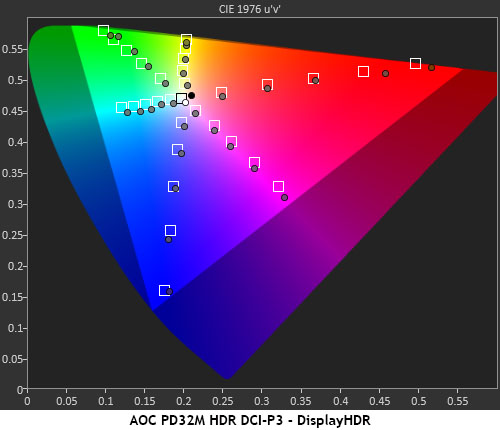Why you can trust Tom's Hardware
Our HDR benchmarking uses Portrait Displays’ Calman software. To learn about our HDR testing, see our breakdown of how we test PC monitors.
Mini LED displays like the PD32M deliver superb HDR. Not only do they offer tremendous dynamic range, but their full-array local-dimming backlights also allow far greater control of picture depth than backlights with only edge or field dimming. It doesn’t get better than this unless you’re an OLED.
HDR Brightness and Contrast



The Samsung Neo G8 is still the output king at over 2,000 nits, but the PD32M is a close second at over 1,650. It’s a good thing there’s a way to dial it down in HDR mode because that is seriously bright. It more than delivers on its promise. Black levels are barely measurable and only when displaying a small info bug at the bottom of the screen. When the screen is fully black, the backlight is turned off. I recorded 216,784.8:1, which is tremendous contrast. Though an OLED panel has the deepest HDR contrast possible from current display technologies, the PD32M and its Mini LED counterparts are very close behind. There is almost no visual difference in a room with some ambient light. And the pictures are stunning in every respect.
Grayscale, EOTF and Color




The PD32M has five HDR picture modes, but the best one is the default, DisplayHDR. It conforms more closely to HDR10 standards than the others. Grayscale tracking is a tad purple, but the error is slight. Light output is so high that the tone-map transition point references to 80%. That means more of the content metadata will conform to the PD32M’s capability, allowing for better HDR. The measurement run makes a soft transition but is still within the realm of visual accuracy. Shadow detail is a tad dark but remains visible.
Color tracking is on-point for both DCI-P3 and Rec.2020. Saturation points are very close to target, meaning you’ll see maximum detail in all parts of the image. I included a chart for the HDR Color+ mode to show that it is not a good choice. It is extremely over-saturated at all the inner points, where most content lies. This gives the picture a cartoonish appearance and is very unrealistic. Bright areas devolve into featureless blobs that are not attractive. Stick with DisplayHDR and you’ll be happy. The PD32M delivers some of the best HDR quality I’ve seen.
MORE: Best Gaming Monitors
MORE: How We Test PC Monitors
Get Tom's Hardware's best news and in-depth reviews, straight to your inbox.
MORE: How to Buy a PC Monitor
MORE: How to Choose the Best HDR Monitor

Christian Eberle is a Contributing Editor for Tom's Hardware US. He's a veteran reviewer of A/V equipment, specializing in monitors. Christian began his obsession with tech when he built his first PC in 1991, a 286 running DOS 3.0 at a blazing 12MHz. In 2006, he undertook training from the Imaging Science Foundation in video calibration and testing and thus started a passion for precise imaging that persists to this day. He is also a professional musician with a degree from the New England Conservatory as a classical bassoonist which he used to good effect as a performer with the West Point Army Band from 1987 to 2013. He enjoys watching movies and listening to high-end audio in his custom-built home theater and can be seen riding trails near his home on a race-ready ICE VTX recumbent trike. Christian enjoys the endless summer in Florida where he lives with his wife and Chihuahua and plays with orchestras around the state.
-
UWguy Did April fools come twice this year? If this was OLED maybe it would justify the price but definitely not as is.Reply
Plus AOC? Gives me flashbacks to the 80’s with their crappy interference laden CRT monitors. -
oofdragon ReplyUWguy said:Did April fools come twice this year? If this was OLED maybe it would justify the price but definitely not as is.
Plus AOC? Gives me flashbacks to the 80’s with their crappy interference laden CRT monitors.
Well this is a advertising website, not a review one.. so you have these amazing products left and right. I do agree that as of today I wont buy a expensive monitor if it's not OLED. They say "but Mini led is brighter!! " Bro I turn brightness down the most I can, I don't want to look at a super bright lamp but at pure black, and make it 240Hz because today that's the new standard -
jakjawagon ReplyThere is no KVM switch, unfortunately.
Yes there is. The monitor's USB ports will connect via either the USB-C port or the USB-B upstream port, depending on which display input is active. Not the most elegant solution, but it's still technically a KVM.
A tiny dongle plugs into one of the USB ports to support the wireless remote.
I'm guessing you're mistaking the included USB stick containing drivers, manuals etc. for a dongle. The remote works fine without plugging it in. -
ra3tonite I have a 1440p monitor but I still play games at 1080p. A lot of games look really great 1080p when playing on a native 1080p monitor. But when I use my 1440p monitor and scale back to 1080p, I notice that the image is not as sharp as when just playing on a native 1080p monitor.Reply
I wonder if using a 4k monitor but scaling back to 1080p for games would have that same blurring effect? Not sure since 2160p to 1080p is a cleaner ratio compared to 1440p to 1080p. I'm not really sure how that stuff works, though. Any thoughts?
